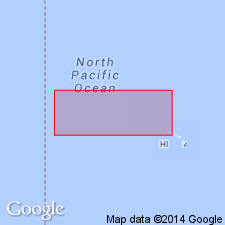
- Usage in publication:
-
- Honolulu volcanic series*
- Modifications:
-
- Named
- Dominant lithology:
-
- Volcanics
- AAPG geologic province:
-
- Oahu
Summary:
Named for occurrence in city of Honolulu and environs [Honolulu, Kaneohe, Koko Head, Mokapu, and Puuloa 7.5' quads] Island of Oahu. Present as many small masses and valley-filling lava flows covering about 27 sq mi on both southwest and northeast flanks of southeast end of Koolau Range. Member units (generally oldest to youngest) include: Hawaiiloa volcanics, Pyramid Rock basalt, Moka Manu volcanics, Ulupau tuff, Mokolea tuff, Rocky Hill volcanics, Kalihi volcanics, Haiku volcanics, Aliamanu tuff, Aliamanu basalt, Kaneohe volcanics, Pali volcanics, Makawao breccia, Kaau volcanics, Mauumae volcanics, Makalapa tuff, Salt Lake tuff, Ainoni volcanics, Maunawili volcanics, Diamond Head tuff, Kaimuki volcanics, Black Point basalt, Kamanaiki basalt, Castle volcanics, Punchbowl volcanics, Diamond Head black ash, Manana tuff, Kalama volcanics, Koko volcanics, Kaohikaipu volcanics, Kaupo basalt, Sugar Loaf basalt, and Tantalus basalt [see individual units]. Overlies with erosional unconformity Koolau volcanics series. Pleistocene sedimentary rocks contemporaneous with Honolulu volcanic series include consolidated calcareous dunes, calcareous marine sediments and noncalcareous deposits mostly in valleys. Recent unconsolidated sediments overlie the Honolulu mostly along beaches. Assigned middle(?) and late Pleistocene, latest Pleistocene or Recent ages based on relationships to Pleistocene shorelines and marine deposits.
Source: GNU records (USGS DDS-6; Menlo GNULEX).
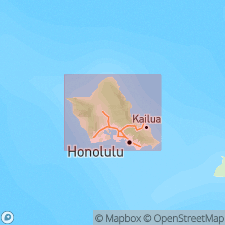
- Usage in publication:
-
- Honolulu volcanic series*
- Modifications:
-
- Age modified
- AAPG geologic province:
-
- Oahu
Summary:
Overlies with erosional unconformity Koolau volcanic series. Pleistocene sedimentary rocks contemporaneous with Honolulu volcanic series include consolidated calcareous dunes, calcareous marine sediments and noncalcareous deposits mostly in valleys. Recent unconsolidated sediments overlie Honolulu volcanic series mostly along beaches. Extent is shown on map. Assigned middle(?) Pleistocene, late Pleistocene, and Recent(?) ages.
Source: GNU records (USGS DDS-6; Menlo GNULEX).
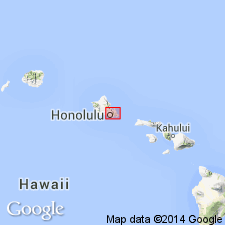
- Usage in publication:
-
- Honolulu series
- Modifications:
-
- Redescribed
- AAPG geologic province:
-
- Oahu
Summary:
Honolulu volcanic series (Stearns, IN Stearns and Vaksvik, 1935) termed Honolulu series. Units correlated with Pleistocene and Recent stands of sea.
Source: GNU records (USGS DDS-6; Menlo GNULEX).
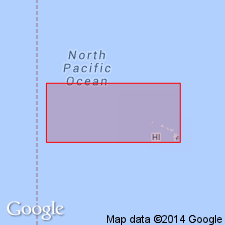
- Usage in publication:
-
- Honolulu volcanic series*
- Modifications:
-
- Age modified
- AAPG geologic province:
-
- Oahu
Summary:
Correlated with successive stands of sea higher or lower than present stand during Pleistocene time. Assigned Pleistocene and Recent age.
Source: GNU records (USGS DDS-6; Menlo GNULEX).
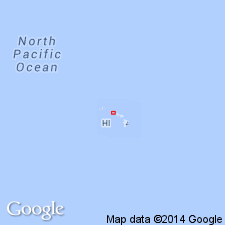
- Usage in publication:
-
- Honolulu volcanic series*
- Modifications:
-
- Age modified
- AAPG geologic province:
-
- Oahu
Summary:
Is composed of group of nepheline basanite, nepheline basalt, and nepheline melilite basalt tuffs and flows that were extruded from about 30 vents in southeast part of Koolau Range. Overlies tholeiites and alkalic basalts of Koolau volcanic series with K-Ar ages in excess of 2 Ma (McDougall 1964). Age of Honolulu volcanic series considered late Pleistocene and Recent.
Source: GNU records (USGS DDS-6; Menlo GNULEX).
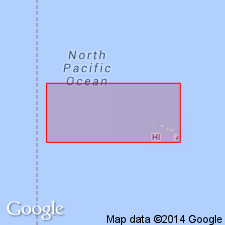
- Usage in publication:
-
- Honolulu volcanic series*
- Modifications:
-
- Geochronologic dating
- AAPG geologic province:
-
- Oahu
Summary:
K-Ar age on whole rock nepheline basalt from "Moiliili [quarry] Oahu" is 0.9 +/-0.5 Ma. [rocks of Moiliili discussed in Stearns, IN Stearns and Vaksvik, 1935]
Source: GNU records (USGS DDS-6; Menlo GNULEX).
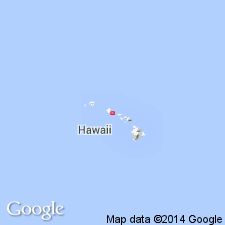
- Usage in publication:
-
- Honolulu Volcanic Series*
- Modifications:
-
- Geochronologic dating
- AAPG geologic province:
-
- Oahu
Summary:
K-Ar ages on lavas from Honolulu Volcanic Series range from 860 +/-10 ka to 31 +/-5 ka.
Source: GNU records (USGS DDS-6; Menlo GNULEX).
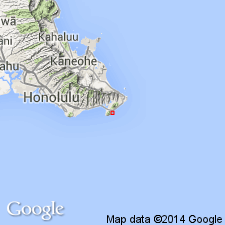
- Usage in publication:
-
- Honolulu Volcanic Series*
- Modifications:
-
- Geochronologic dating
- AAPG geologic province:
-
- Oahu
Summary:
One of last volcanic events on Oahu was ejection from Koko Crater of blanket of fine, black, basaltic ash which forms veneer on summit of Koko Crater and appears as remnant outcrops on surrounding lowlands. Carbon-14 ages of coral reef show reef began to grow about 7000 yr ago. Coral colony of reef may have grown on tuff and then black ash deposited and then eroded away or coral colony might have started to grow before eruption of black ash. On basis of 1st explanation black ash occurred at least 7,000 yr ago. If 2nd explanation is correct, eruption occurred in interval 7,000 to 5,500 yr ago.
Source: GNU records (USGS DDS-6; Menlo GNULEX).
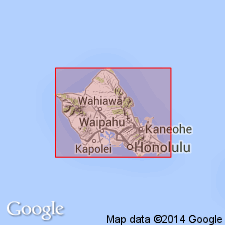
- Usage in publication:
-
- Honolulu Volcanics*
- Modifications:
-
- Revised
- Geochronologic dating
- AAPG geologic province:
-
- Oahu
Summary:
[Honolulu Volcanic Series (Stearns, IN Stearns and Vaksvik, 1935) here reduced in rank and renamed Honolulu Volcanics.] K-Ar ages on basalts from 12 vents of Honolulu Volcanics suggest post-erosional stage of volcanic eruption between 0.6 and 0.3 Ma.
Source: GNU records (USGS DDS-6; Menlo GNULEX).

- Usage in publication:
-
- Honolulu Volcanic Series*
- Modifications:
-
- Geochronologic dating
- AAPG geologic province:
-
- Oahu
Summary:
K-Ar ages on basalts from 12 vents of Honolulu Volcanic Series range from 2.01 +/-0.05 to 0.32 +/-0.04 Ma. In comparing results with Gramlich and others (1971) authors state "If internal consistency and reproducibility are used as criteria for evaluating the K-Ar data, then only six basalts in our study yield acceptable ages. [ranging from 0.58 +/-0.025 to 0.32 +/-0.04 Ma]
Source: GNU records (USGS DDS-6; Menlo GNULEX).
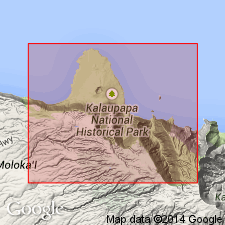
- Usage in publication:
-
- Honolulu Group*
- Modifications:
-
- Revised
- AAPG geologic province:
-
- Oahu
Summary:
Honolulu Group (formerly Honolulu Volcanic Series of Stearns, IN Stearns and Vaksvik, 1935; also formerly Honolulu Volcanics of Lanphere and Dalrymple, 1979) is here renamed in order to meet provisions of art. 9(a) and 9(f) of Code of Stratigraphic Names (1970).
Source: GNU records (USGS DDS-6; Menlo GNULEX).
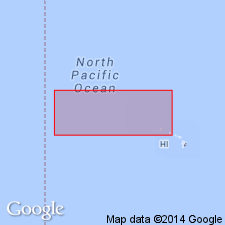
- Usage in publication:
-
- Honolulu Formation
- Modifications:
-
- Revised
- AAPG geologic province:
-
- Oahu
Summary:
Honolulu Volcanic Series (Stearns, IN Stearns and Vaksvik, 1935) changed to Honolulu Formation. "Following the usage of Macdonald (1978), most volcanic series have been renamed as Formation..." "No systematic attempt is being made to revise volcanic stratigraphic nomenclature in Hawaii." Map of vents and rifts is included.
Source: GNU records (USGS DDS-6; Menlo GNULEX).
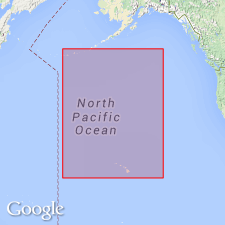
- Usage in publication:
-
- Honolulu Volcanics*
- Modifications:
-
- Geochronologic dating
- AAPG geologic province:
-
- Oahu
Summary:
K-Ar "ages for lava of the rejuvenated-stage Honolulu Volcanics range from about 0.9 to 0.03 Ma."
Source: GNU records (USGS DDS-6; Menlo GNULEX).
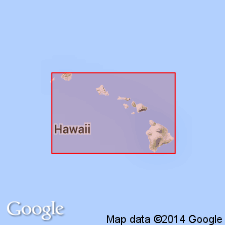
- Usage in publication:
-
- Honolulu Volcanics*
- Modifications:
-
- Revised
- AAPG geologic province:
-
- Oahu
Summary:
Honolulu Volcanic Series (Stearns, IN Stearns and Vaksvik, 1935) and Honolulu Group (Clague and others, 1982) reduced from group rank to formational rank. Lanphere and Dalrymple (1979) and Clague and Frey (1982) used formational rank term, Honolulu Volcanics, but did not address status of its formally named subdivisions. Term Honolulu Volcanics is retained to reflect its range of lithologic compositions. Formally named eruptive units have been reduced in rank and all considered to be informal units of Honolulu Volcanics. Is in part of Pleistocene age "but because of unreliability of some of the ages, a Holocene age cannot be ruled out for the youngest flows."
Source: GNU records (USGS DDS-6; Menlo GNULEX).
For more information, please contact Nancy Stamm, Geologic Names Committee Secretary.
Asterisk (*) indicates published by U.S. Geological Survey authors.
"No current usage" (†) implies that a name has been abandoned or has fallen into disuse. Former usage and, if known, replacement name given in parentheses ( ).
Slash (/) indicates name conflicts with nomenclatural guidelines (CSN, 1933; ACSN, 1961, 1970; NACSN, 1983, 2005, 2021). May be explained within brackets ([ ]).

